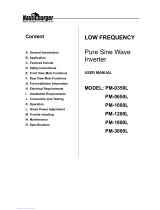
SECTION 2 | General Information
8
Surge Power Rating: During start up, certain loads require considerably higher
surge of power for short duration (lasting from tens of millisecs to few seconds) as
compared to their Maximum Continuous Running Power Rating. Some examples of
such loads are given below:
• Electric Motors: At the moment when an electric motor is powered ON, the rotor
is stationary (equivalent to being “Locked”), there is no “Back EMF” and the
windings draw a very heavy surge of starting current (Amperes) called “Locked
Rotor Amperes” (LRA) due to low DC resistance of the windings. For example,
in motor driven loads like Air-conditioning and Refrigeration Compressors and
in Well Pumps (using Pressure Tank), the Starting Surge Current / LRA may be as
high as 10 times its rated Full Load Amps (FLA) / Maximum Continuous Running
Power Rating. The value and duration of the Starting Surge Current / LRA of the
motor depends upon the winding design of the motor and the inertia / resistance
to movement of mechanical load being driven by the motor. As the motor speed
rises to its rated RPM, “Back EMF” proportional to the RPM is generated in the
windings and the current draw reduces proportionately till it draws the running
FLA / Maximum Continuous Running Power Rating at the rated RPM.
• Transformers (e.g. Isolation Transformers, Step-up / Step-down Transformers,
Power Transformer in Microwave Oven etc.): At the moment when AC power
is supplied to a transformer, the transformer draws very heavy surge of
“Magnetization Inrush Current” for a few millisecs that can reach up to 10 times
the Maximum Continuous Rating of the Transformer.
• Devices like Infrared Quartz Halogen Heaters (also used in Laser Printers) / Quartz
Halogen Lights / incandescent Light Bulbs using Tungsten heating elements:
Tungsten has a very high Positive Temperature Coefficient of Resistance i.e. it has
lower resistance when cold and higher resistance when hot. As Tungsten heating
element will be cold at the time of powering ON, its resistance will be low and
hence, the device will draw very heavy surge of current with consequent very
heavy surge of power with a value of up to 8 times the Maximum Continuous
Running AC Power.
• AC to DC Switched Mode Power Supplies (SMPS): This type of power supply is
used as stand-alone power supply or as front end in all electronic devices powered
from Utility / Grid e.g. in audio / video / computing devices and battery chargers
(Please see Section 4 for more details on SMPS). When this power supply is
switched ON, its internal input side capacitors start charging resulting in very high
surge of Inrush Current for a few millisecs (Please see fig 4.1). This surge of inrush
current / power may reach up to 15 times the Continuous Maximum Running
Power Rating. The surge of inrush current / power will, however, be limited by the
Surge Power Rating of the AC source.
Power Factor, (PF): It is denoted by “PF” and is equal to the ratio of the Active Power
(P) in Watts to the Apparent Power (S) in VA. The maximum value is 1 for resistive
types of loads where the Active Power (P) in Watts = the Apparent Power (S) in VA.
It is 0 for purely inductive or purely capacitive loads. Practically, the loads will be
a combination of resistive, inductive and capacitive elements and hence, its value























